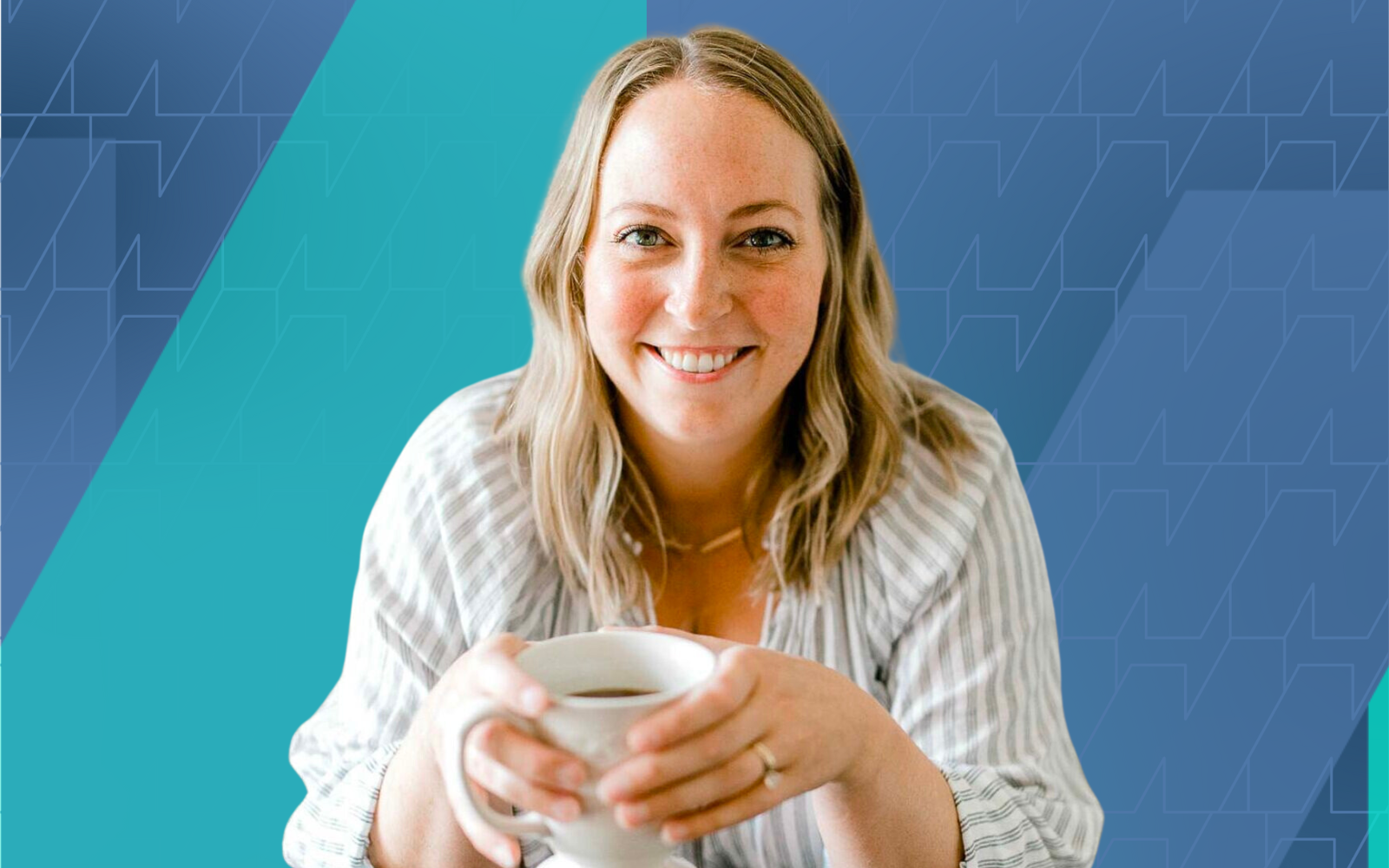Callan Wenner was plugging away at her corporate job when she realized she needed a creative outlet.
She had always been very adept in the kitchen, and had even considered culinary school at one point, but in the end she decided to take her passion online.
She started a blog called The Cozy Plum as a place to share her recipes. When she realized that blogging could actually be a lucrative business, she went all-in.
Today her blog earns $5k per month and gives her the freedom and flexibility to work when she wants and stay home with her son.
Keep reading to find out:
- What she thought blogging was going to be like
- When she realized what blogging was actually about
- Where her income comes from
- How much traffic her site gets
- Her main marketing strategies
- Her thoughts on SEO
- How she conveys her expertise
- Her detailed approach to keyword research
- Her internal linking strategy
- How she creates content
- How she grows her email list
- The resources and tools she uses
- Her biggest challenge
- Her main accomplishment
- Her worst mistake
- Her advice for other entrepreneurs
Meet Callan Wenner
My name is Callan (like calendar) and I come from a relatively rural area in central Pennsylvania.
I played Division I water polo in college, which took me to northern California for about 6 years before I moved back east to attend graduate school.
I then lived and worked in Pittsburgh, PA for 5 years (where I was dating my now husband), and finally moved back to my hometown where my husband and I recently had a baby boy (our first child).
I’ve always been very adept in the kitchen and considered culinary school (very expensive), but it wasn’t until the pandemic that I decided to turn my hobby into something more.
Why She Created Her Site
Like a lot of newer bloggers, I started The Cozy Plum in spring of 2020… the early pandemic days. I was looking for a creative outlet and have always loved being in the kitchen—it’s my happy place—so I decided to start a blog to host my recipes as a side project.
I naively thought my unique recipes were amazing and I could trick Google by just providing a small amount of text and a recipe card. I was always hearing people say they just wanted to “get to the recipe,” so I thought I was giving users what they wanted.
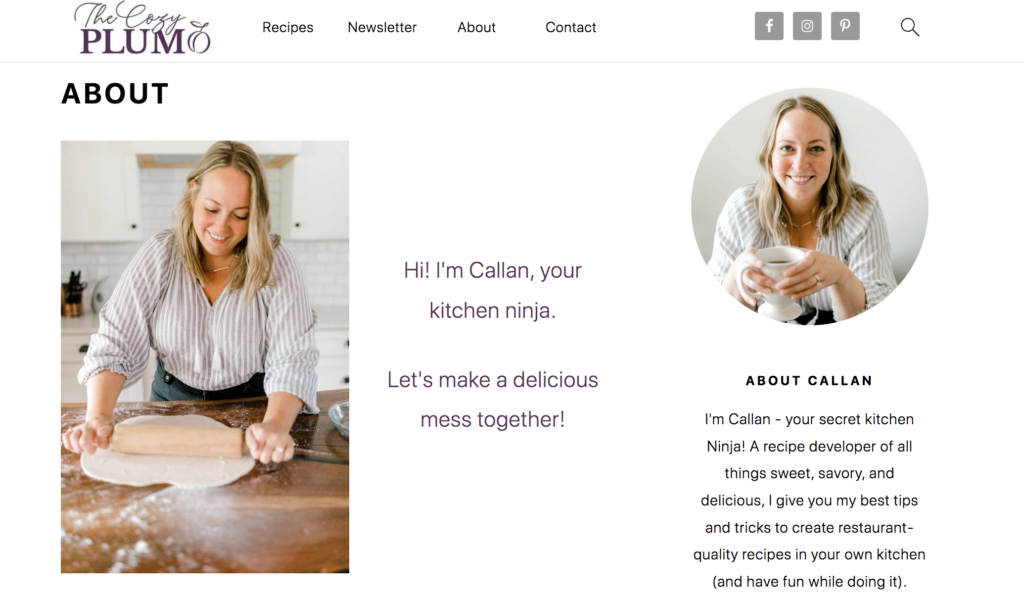
I quickly learned that nobody was searching for things like mango coconut marshmallows, one of my earlier recipes, and started diving into what really goes into running a successful blog: keyword research, SEO, UX, digital content creation, running a small business, etc.
That’s when I realized that blogging is a very lucrative business and I could make a very good living doing something I loved.
I invested in a blogging mentorship program to help me learn the basic ins and outs of blogging and quickly start attacking mistakes I had been making. It was 1.5 years after the program that I qualified for Mediavine and began making an income from my website.
The ultimate goal of starting my own business was that I wanted to work for myself, make my own rules, and have flexibility in my life to travel and take time off.
I also wanted to have a job that allowed me to be at home with my children when the time came. I can now say that I’ve achieved that goal.
How Much She’s Making
For the past year, I have averaged $5k per month as a base income solely from my website and one photography client.
I first monetized my website in October 2022. You can see here the earnings difference that one year has made on my website. This number will continue to increase as I have honed in on my keyword research, SEO practices, and overall website authority.

I also take on additional freelance projects as my schedule permits. This includes recipe development and photography and videography for national brands, sponsored social media posts, and ghost content creation for other bloggers or brands’ social media.
This varies by month, but I do not accept a project for less than $1500 solely due to my own cost of doing business. One-off projects typically range from $2,000 to $6,000.
Because I’m a food blogger, specifically desserts and special occasion appetizers, seasonality affects my website.
In the summer months when there aren’t any major holidays and people don’t want to have their oven on in the heat, I average around 50k sessions.
Once quarter 4 hits, that number doubles and I sit around 120k sessions.
January also has a huge decline in website numbers and revenue. Everyone is trying to clean up their eating habits after the holidays and sweet indulgences are at a minimum.
I also see a significant decline in “unfollows” on Instagram as a result of this.
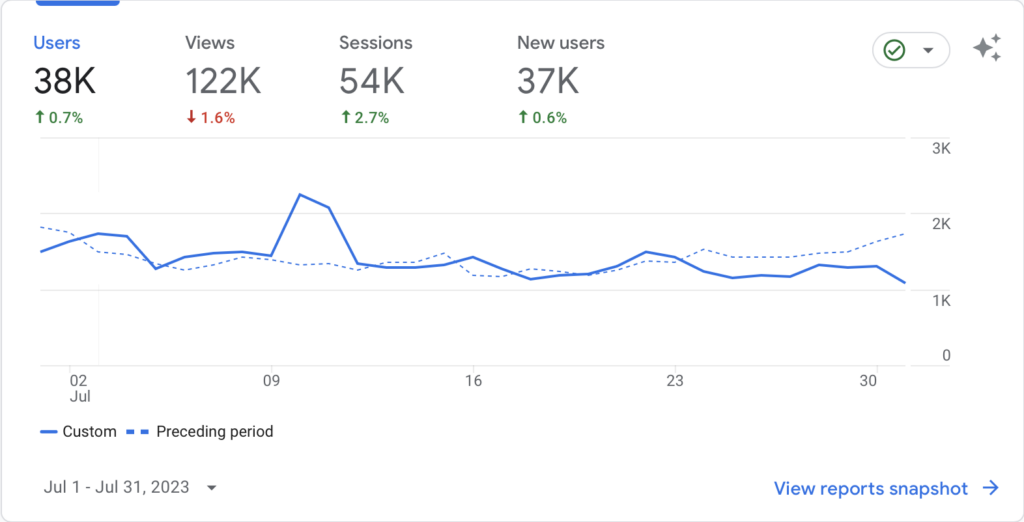
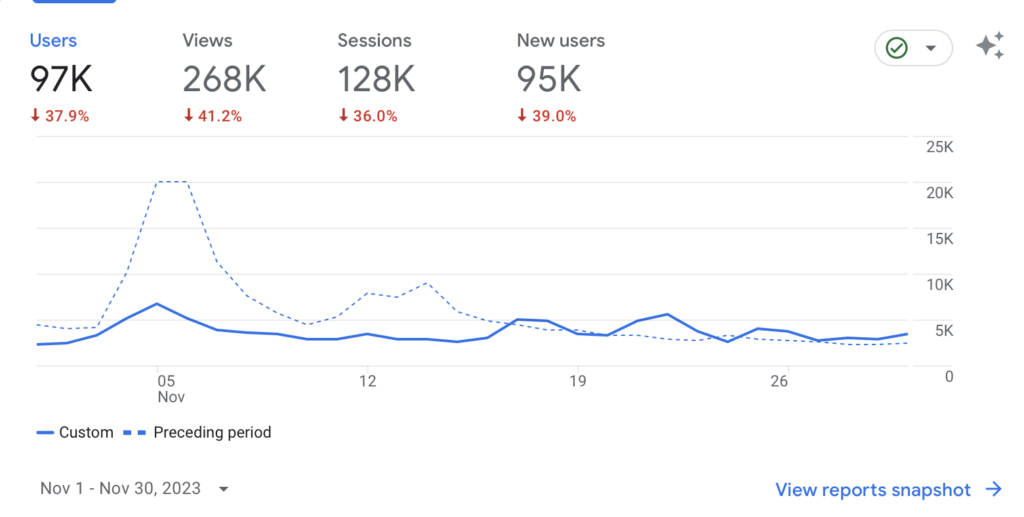
Her Main Marketing Strategy
My marketing strategy is consistency.
I have a dedicated schedule for each of the following: blog posts, Google web stories, email newsletters, Pinterest, Instagram, and Facebook. These are my highest-traffic drivers.
This year, I plan to be more consistent on YouTube, so I’m curious to see how that turns out. I’m pushing out content through as many channels as I can actively handle, and where I have the most dedicated community who trust me as their kitchen expert.
I also submit my recipes to FoodTalk, which can be controversial for food bloggers as the platform essentially scrapes your blog post to their website. However, I’ve never seen this compete with any of my actual blog posts, so I don’t see it as a problem (right now).
They have an incredibly robust email list, and because I have a good following to my profile, my recipes get featured in their email almost every month. I can submit 3 recipes a month for a feature, so I specifically choose recipes that show high RPMs via my Mediavine dashboard.
When I land one of those email features, I always see a spike in traffic and income.
I work 30 to 40 hours per week on my business.
Prior to having a baby, it was closer to 50 to 60, but I have outsourced more of my tasks, which has freed up time. I’ve started working smarter, not harder.
Her Thoughts on SEO
Website visibility and a strong online presence are a huge part of the blogging side of my business. The more visible my website, the more traffic, and the higher my earnings.
When first starting my business, I had put a lot of focus on growing a social media following. However, once my website was monetized and I had access to more earnings data, I dove into SEO more than ever.
For example, average RPMs from organic search in October 2023 were $34.79, while RPMs from Instagram were $11.90.
My apple crumble cheesecake went viral on Instagram with over 12 million views, which brought around 67k to my website in October from Instagram, but only resulted in roughly $300 because of the RPM conversion.
Because of this, I specifically focus on growing visibility for search queries organically. I also really focus on internal linking which helps my EAT (expertise, authoritativeness, and trustworthiness), shows me as an expert, and builds my overall brand equity.
I make sure all of my blog posts and website pages (including category pages) and on-page elements are optimized.
I’m writing for the user… to give them the information they’re looking for as quickly and clearly as possible, rather than just keyword stuffing to get into the SERPs.
It’s a long-term strategy, but when looking at your YOY data, it’s obvious that it pays off.
Keyword Research
I use a few different methods and programs to conduct my keyword research. If I’m just starting out, have no idea what recipe I want to make, and want to get some ideas, I head over to Google, paired with a plugin called Keywords Everywhere which populates monthly search amounts with queries.
I’ll use the ABC method to create a list of ideas.
For example, if I know I want to make a cake, I’ll write down various types of cakes to do the method with: bundt cake, single layer cake, snack cake, layer cake, sheet cake, etc.
I put “bundt cake recipe” into the search bar then hit the space button. Google will automatically populate search queries about this with bolded terms. I see “chocolate bundt cake” and that seems appetizing and is something I want to explore further.
I change the search term to “chocolate bundt cake” and hit the spacebar. I write down all of the bolded modifiers. Then, I go through every letter of the alphabet with the letters on both the back end and front end of the search term and write down what populates.
These are popular search queries connected to your head keyword.
From there, I head over to KeySearch and search the terms I’m interested in to check the monthly search volume, competitor URLs and domain authority, and related search terms.
If the query ticks my personal boxes (more than 1k monthly search volume, ability to rank top 10, aligns with my brand, etc), then it goes on my running keyword list for consideration.
I then refer to that keyword list to think about seasonality and holidays, as I’m planning out my recipes each month.
In addition to this method, I also use RankIQ to build supporting posts and also research queries to use as H2s in related posts.
If you’re interested in food blogging, I highly suggest taking the Cooking with Keywords course, which is how I learned how to efficiently and successfully conduct keyword research.
Internal Linking and Link Building
Link building is incredibly important, especially for EAT.
Within my own website, I use the LinkWhisper plugin to recommend internal links that I should touch on based on what I’m writing about.
When I first started, I was always linking to other blog posts via the actual recipe name. However, this wasn’t really benefitting me because I was constantly linking to the same exact keyword.
There are hundreds, sometimes thousands of keywords that each recipe can rank for, so I had to adapt my strategy to link those posts to other ranking keywords.
For example, if I’m writing a brownie post and describing “fudgy brownies” I will link another brownie post to the words fudgy brownies, as that is a keyword I’d like to rank higher for.
To build links externally, I submit recipes to recipe roundup groups on Facebook, speak on podcasts, and do interviews.
Callan’s Content Creation Strategy
After deciding on my keyword and general recipe, I write out the recipe and test.
If I’m using a base recipe that I already have, I pretty much know it will work out. However, sometimes I have to test recipes multiple times, especially baking recipes.
During this process, I take both process shots and videos simultaneously. This allows me to condense the process so I get all the digital content I need in one go. Once the dish is finished, I take final photos and final videos.
From there, I export, cull, and organize all files. Photos get exported from Lightroom and sent to my photo editor. I edit each recipe into 3 videos (1 minute, 30 seconds, and 10 to 15 seconds).
Once the photos come back, I load them into WordPress and into the base recipe template, along with the final recipe in the recipe card and the step-by-step-instructions within the blog post.
From there, I send my keyword research spreadsheet to my writer, who writes the rest of the blog post, incorporating necessary keywords and descriptions.
I review the blog post, publish, add the 1-minute video to my recipe card, then add the recipe to my schedule to promote via Google web stories, Pinterest, Instagram, and Facebook.
This gets repeated for every recipe, which is up to 8 per month.
Her Email List
I currently have almost 3,000 subscribers on my main email list. I call these my MVPs, as these are the folks who are really tuned in to my offerings and are most likely to make my recipes.
I send out a bi-weekly email with new and featured recipes, as well as tidbits of what’s going on behind the scenes.
I use various CTAs on different pages of my website, pop-ups if I’m offering something specific (like a guide), a spotlight feature in the middle of every blog post, and in Instagram stories.
My main audience sign-up has an intro email sequence which sends out a series of three emails after signing up.
This includes what they can expect from The Cozy Plum, how to find success in my recipes, and the top 10 recipes from the past year to get them started.
I also recently joined the ConvertKit creator program, which allows you to suggest other creators your audience may enjoy (upon sign-up) and vice versa. I don’t have enough data on this, yet, but I’m hopeful that it will bring more subscribers.
Finally, I have an additional email list that goes specifically to brands or clients I’ve worked with in the past.
This goes out twice a year and includes recent projects and what I’ve been up to in a freelance capacity. It helps to keep me top-of-mind for projects and allows brands to see what I can offer them.
Her Favorite Resources
My go-to resources are:
- Podcasts/Webinars: Food Blogger Pro, Eat Blog Talk, SEO for Bloggers
- YouTube: The Bite Shot
- Paid courses: Cooking with Keywords, food blogging mentorship programs, business coaching
Her Favorite Tools
The most useful tools are my project management systems.
I specifically use these programs as they allow me to automate my processes, reduce unnecessary communication with my team, and keep me on track with blog posts and project deadlines.
Asana: I use this as my personal project management system to be sure no pieces are falling through the cracks.
For example, I have a 26-step checklist for every single item I need to complete per recipe with date-specific deadlines.
AirTable: These spreadsheets are used to compile all data for my blog posts, including targeted keywords, months to promote, and post IDs, which helps me easily add the posts into customized blocks on my homepage.
I also use them to create and share schedules with my contractors, which I embed with email triggers upon status changes (i.e. “post loaded to WordPress,” “blog post complete”).
These are used for my writer, Pinterest VA, and Google Web Stories VA.
Honeybook: I use this program as my CRM to keep track of client information and communication, and my invoicing system.
It automatically sends reminders to clients to pay an invoice so I can be totally hands-off.
Callan’s Biggest Challenge
The biggest challenge was learning how to be my own boss and adapting to the flexibility. I’d say it’s the best and worst part about running an online business.
It’s so easy to give in to the feeling of not wanting to work on a specific day, but choosing to work anyway.
At the beginning, it was difficult to have fluctuating monthly income after being used to a very steady income in my corporate job.
It took some time to figure out exactly what I needed to run my business and which expenses could wait until I was bringing in more money.
Her Greatest Accomplishment
Building my business from the ground up.
I knew how to create an awesome, enticing recipe…I did not know much else.
I taught myself how to build and maintain my website, how to keyword research, market myself on social media, negotiate contracts, learn drool-worthy photography and videography, website analytics, manage a team, and stay on top of the changing landscape of the online world. And so much more!
When I feel like “I’m not successful enough yet,” I remind myself that I’ve built all of this from my own determination and will only continue to grow.
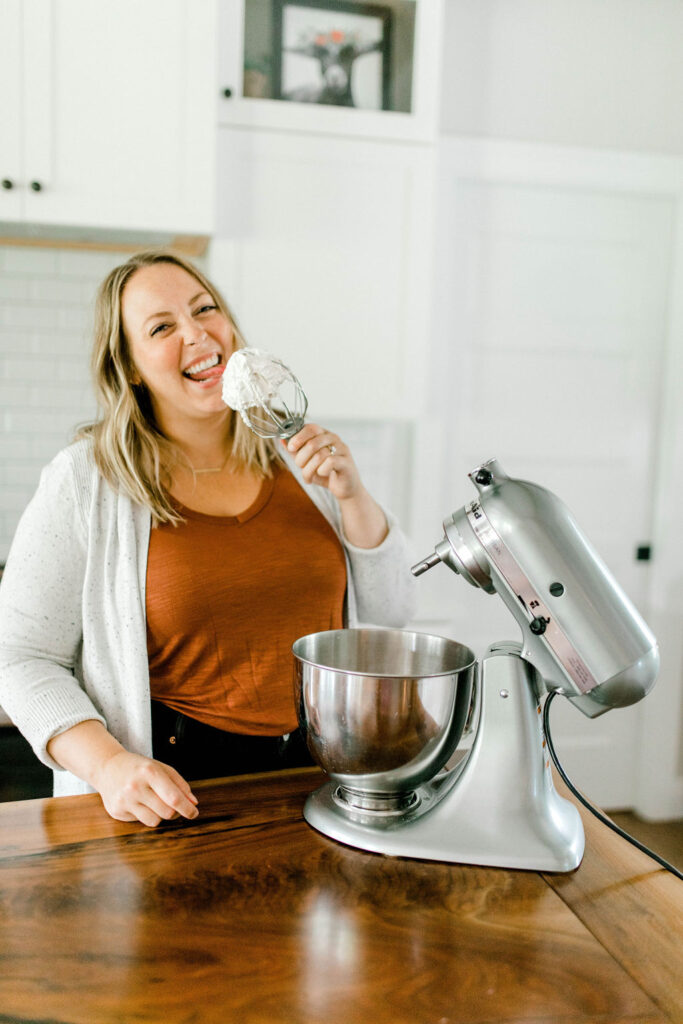
What She Wishes She Knew When She Started
I wish I had known about SEO.
I spent too much time with my head buried in the sand and would have monetized my website much faster if I had taken the time to learn more about keyword research and SEO best practices.
I’m still paying for that naivety by updating old blog posts when I could be spending time focusing on other ways to bring in income or diversify.
But thin content is not beneficial to my website, so I need to get those updates done.
Her Biggest Mistake
I don’t think I can say that I’ve made any huge mistakes thus far, but there are definitely some things that I wish I’d done differently.
First, I’d immediately focus on SEO and website presence. At first, I had a larger focus on growing an Instagram following, but I don’t own Instagram and it could go away at any moment, and the RPMs for website traffic via Instagram are abysmal.
Second, I’d learn how to price my services and negotiate contracts with brands right off the bat.
I’ve definitely underpriced myself on a number of projects simply because I didn’t understand my own cost of doing business and what my absolute baseline price per project needed to be.
Third, I wish I had outsourced sooner. When you aren’t making a lot of money yet, it’s easy to want to take on that work yourself. But for my business, time is money.
Paying other people to do the work that I don’t want to do (or takes a lot of time) frees up my schedule to run the parts of my business that allow me to continue to bring in money.
Her Advice for Other Entrepreneurs
Building a business from the ground up is a marathon, not a sprint. I still tell myself this every day. The to-do list is endless, and some days you get more done than other days.
Throughout every year, there will be highs and lows, and it can be lonely when you’re putting in the long hours.
Figure out why you are doing what you do and remind yourself of that whenever the days feel especially tough.
